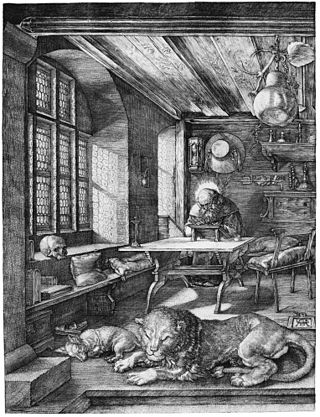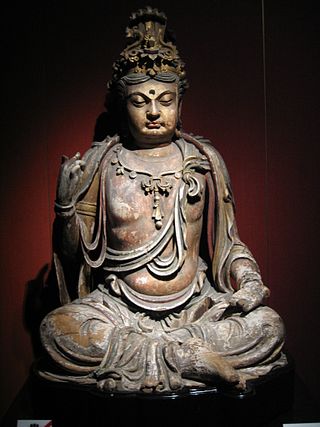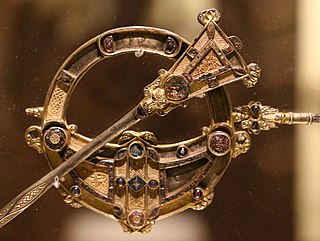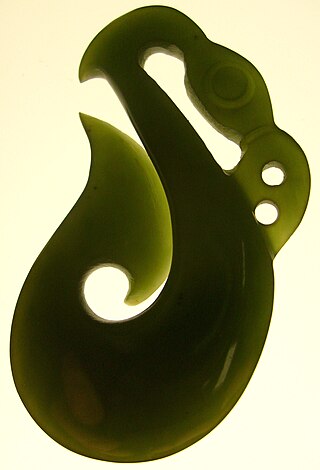
A knife is a tool or weapon with a cutting edge or blade, usually attached to a handle or hilt. One of the earliest tools used by humanity, knives appeared at least 2.5 million years ago, as evidenced by the Oldowan tools. Originally made of wood, bone, and stone, over the centuries, in step with improvements in both metallurgy and manufacturing, knife blades have been made from copper, bronze, iron, steel, ceramic, and titanium. Most modern knives have either fixed or folding blades; blade patterns and styles vary by maker and country of origin.

Engraving is the practice of incising a design onto a hard, usually flat surface by cutting grooves into it with a burin. The result may be a decorated object in itself, as when silver, gold, steel, or glass are engraved, or may provide an intaglio printing plate, of copper or another metal, for printing images on paper as prints or illustrations; these images are also called "engravings". Engraving is one of the oldest and most important techniques in printmaking.

Islamic art is a part of Islamic culture and encompasses the visual arts produced since the 7th century CE by people who lived within territories inhabited or ruled by Muslim populations. Referring to characteristic traditions across a wide range of lands, periods, and genres, Islamic art is a concept used first by Western art historians since the late 19th century. Public Islamic art is traditionally non-representational, except for the widespread use of plant forms, usually in varieties of the spiralling arabesque. These are often combined with Islamic calligraphy, geometric patterns in styles that are typically found in a wide variety of media, from small objects in ceramic or metalwork to large decorative schemes in tiling on the outside and inside of large buildings, including mosques. Other forms of Islamic art include Islamic miniature painting, artefacts like Islamic glass or pottery, and textile arts, such as carpets and embroidery.

Metalworking is the process of shaping and reshaping metals to create useful objects, parts, assemblies, and large scale structures. As a term it covers a wide and diverse range of processes, skills, and tools for producing objects on every scale: from huge ships, buildings, and bridges down to precise engine parts and delicate jewelry.

Wood carving is a form of woodworking by means of a cutting tool (knife) in one hand or a chisel by two hands or with one hand on a chisel and one hand on a mallet, resulting in a wooden figure or figurine, or in the sculptural ornamentation of a wooden object. The phrase may also refer to the finished product, from individual sculptures to hand-worked mouldings composing part of a tracery.

A blade is the portion of a tool, weapon, or machine with an edge that is designed to puncture, chop, slice or scrape surfaces or materials. Blades are typically made from materials that are harder than those they are to be used on. Historically, humans have made blades from flaking stones such as flint or obsidian, and from various metal such as copper, bronze and iron. Modern blades are often made of steel or ceramic. Blades are one of humanity's oldest tools, and continue to be used for combat, food preparation, and other purposes.

A Japanese kitchen knife is a type of a knife used for food preparation. These knives come in many different varieties and are often made using traditional Japanese blacksmithing techniques. They can be made from stainless steel, or hagane, which is the same kind of steel used to make Japanese swords. Most knives are referred to as hōchō or the variation -bōchō in compound words but can have other names including -kiri. There are four general categories used to distinguish the Japanese knife designs: handle, blade grind, steel, and construction.

Stone carving is an activity where pieces of rough natural stone are shaped by the controlled removal of stone. Owing to the permanence of the material, stone work has survived which was created during our prehistory or past time.

A kitchen knife is any knife that is intended to be used in food preparation. While much of this work can be accomplished with a few general-purpose knives – notably a large chef's knife, a tough cleaver, a small paring knife and some sort of serrated blade – there are also many specialized knives that are designed for specific tasks. Kitchen knives can be made from several different materials.

The Santoku bōchō or Bunka bōchō (文化包丁) is a general-purpose kitchen knife originating in Japan. Its blade is typically between 13 and 20 cm long, and has a flat edge and a sheepsfoot blade that curves down an angle approaching 60 degrees at the point. The term Santoku may refer to the wide variety of ingredients that the knife can handle: meat, fish and vegetables, or to the tasks it can perform: slicing, chopping and dicing, either interpretation indicating a multi-use, general-purpose kitchen knife. The Santoku's blade and handle are designed to work in harmony by matching the blade's width and weight to the weight of the tang and the handle.

Filigree is a form of intricate metalwork used in jewellery and other small forms of metalwork.

Anglo-Saxon art covers art produced within the Anglo-Saxon period of English history, beginning with the Migration period style that the Anglo-Saxons brought with them from the continent in the 5th century, and ending in 1066 with the Norman Conquest of England, whose sophisticated art was influential in much of northern Europe. The two periods of outstanding achievement were the 7th and 8th centuries, with the metalwork and jewellery from Sutton Hoo and a series of magnificent illuminated manuscripts, and the final period after about 950, when there was a revival of English culture after the end of the Viking invasions. By the time of the Conquest the move to the Romanesque style is nearly complete. The important artistic centres, in so far as these can be established, were concentrated in the extremities of England, in Northumbria, especially in the early period, and Wessex and Kent near the south coast.

Sharpening is the process of creating or refining the edge joining two non-coplanar faces into a converging apex, thereby creating an edge of appropriate shape on a tool or implement designed for cutting. Sharpening is done by removing material on an implement with an abrasive substance harder than the material of the implement, followed sometimes by processes to polish/hone the sharp surface to increase smoothness.

Wood carving is one of the oldest arts of humankind. Wooden spears from the Middle Paleolithic, such as the Clacton Spear, reveal how humans have engaged in utilitarian woodwork for millennia. However, given the relatively rapid rate at which wood decays in most environments, there are only isolated ancient artifacts remaining.
The following outline is provided as an overview of and topical guide to crafts:
Among arts and crafts that come out of Himachal Pradesh state in India are carpets, leather works, shawls, metalware, woodwork and paintings. Pashmina shawl is the product which is highly in demand not only in Himachal but all over the country. Colourful Himachali caps are also famous art work of the people. One tribe, Dom, is expert in manufacturing bamboo items like boxes, sofas, chairs, baskets and racks. Metalware of the state include utensils, ritualistic vessels, idols, gold and silver jewelleries.

The Celtic brooch, more properly called the penannular brooch, and its closely related type, the pseudo-penannular brooch, are types of brooch clothes fasteners, often rather large; penannular means formed as an incomplete ring. They are especially associated with the beginning of the Early Medieval period in Ireland and Britain, although they are found in other times and places—for example, forming part of traditional female dress in areas in modern North Africa.

The Manaia is a mythological creature in Māori culture, and is a common motif in Māori carving and jewellery.

The Middle Ages was a period that spanned approximately 1000 years and is normally restricted to Europe and the Byzantine Empire. The material remains we have from that time, including jewelry, can vary greatly depending on the place and time of their creation, especially as Christianity discouraged the burial of jewellery as grave goods, except for royalty and important clerics, who were often buried in their best clothes and wearing jewels. The main material used for jewellery design in antiquity and leading into the Middle Ages was gold. Many different techniques were used to create working surfaces and add decoration to those surfaces to produce the jewellery, including soldering, plating and gilding, repoussé, chasing, inlay, enamelling, filigree and granulation, stamping, striking and casting. Major stylistic phases include barbarian, Byzantine, Carolingian and Ottonian, Viking, and the Late Middle Ages, when Western European styles became relatively similar.

Art in Medieval Scotland includes all forms of artistic production within the modern borders of Scotland, between the fifth century and the adoption of the Renaissance in the early sixteenth century. In the early Middle Ages, there were distinct material cultures evident in the different federations and kingdoms within what is now Scotland. Pictish art was the only uniquely Scottish Medieval style; it can be seen in the extensive survival of carved stones, particularly in the north and east of the country, which hold a variety of recurring images and patterns. It can also be seen in elaborate metal work that largely survives in buried hoards. Irish-Scots art from the kingdom of Dál Riata suggests that it was one of the places, as a crossroads between cultures, where the Insular style developed.


















